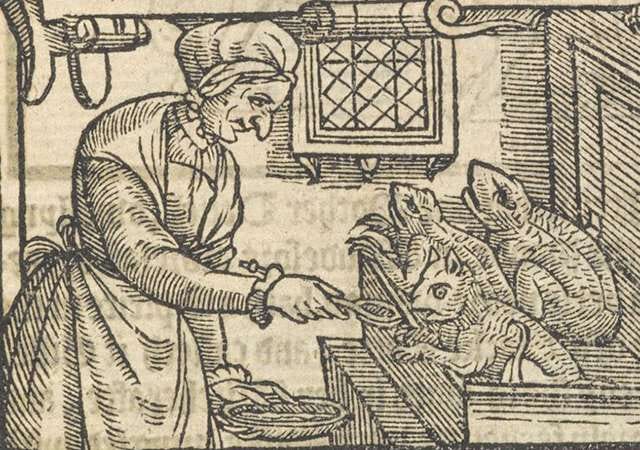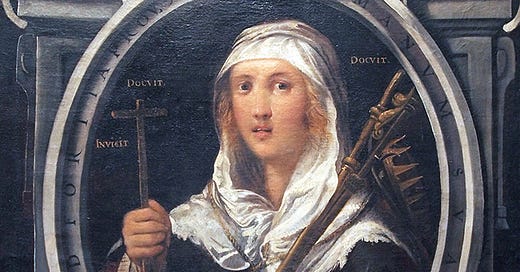St. Walpurga: Missionary and Abbess
How a Nice Lady From England Got Tangled Up in Witch Stories
Apologies for having taken a hiatus in my saints’ histories. I had to deal with a large cataclysm and wound up needing to lay low online for a while. IYKYK. I’m writing this on February 25, which is the date most Christians use to commemorate St. Walpurga. What? You haven’t heard of her? Then you’re in for a treat! Or even if you have, prepare to indulge in a second serving.
Walpurga was born around 710 in Wessex (present-day Devon) to saintly parents. And I mean that literally, since the Catholic Church also canonized both of her parents. Walpurga’s father, Richard (not his real name) was a king in Wessex who decided to abdicate the throne, give up his land holdings, and make a pilgrimage to the Holy Land in 720. By this time Richard’s wife had already passed away and so he decided to take two sons on pilgrimage with him and arrange for an abbey in Dorset to care for the young Walpurga.
Sadly, after about a year at the abbey, Walpurga received word that her father had died unexpectedly before reaching his earthly destination. While Walpurga’s brothers battled their own illnesses and eventually worked their way back to Europe, Walpurga became a Benedictine nun and formally entered the abbey. Since monasteries at this time were centers of learning, Walpurga received an excellent education and learned to write in Latin. This enabled her to write an account of her brother St. Winibald’s journey to the Holy Land. This means that Walpurga may be England’s first “published” female author!
In 737, Walpurga’s uncle (probably her mother’s brother), St. Boniface, was preparing for a third mission trip to the pagan German lands to the north. Needing more harvesters in the vast fields of northern Europe, Boniface turned to his family. Walpurga and two of her brothers immediately answered the call. After living in an abbey for over twenty years, Walpurga made the dangerous journey to modern-day Bavaria. There she joined the Heidenheim double-monastery (a community with both monks and nuns who shared some common buildings) founded by her brothers Sts. Winibald and Willibald.
Walpurga’s piety, wisdom, leadership skills, and winsomeness allowed her to eventually become the the superior of both the male and female monastic communities. St. Walpurga died of natural causes on February 25 sometime around 778. Nearly one hundred years later, Walpurga’s remains were moved to a family plot in Eichstätt. Christians began celebrating the life of Walpurga both on her heavenly birthday and on May 1, in honor of the “transfer” of her “relics.”
But wait, you’re thinking. What about the witches?! Hang tight, here we go. Walpurga’s successful evangelization of pagans in Germany led later Christians to associate her with protection against witchcraft. Also, remember I just said many Christians began commemorating St. Walpurga on May 1? Well, May 1 was likely the date of many pagan festivals celebrating the beginning of summer. Perhaps for this reason or because of the association between Walpurga and witchcraft, many medieval and early-modern Germans believed April 30, or Walpurgisnacht, was the hottest day on the calendar for witch activity.

According to folk belief, witches would gather for Walpurgisnacht “sabbaths” to plot their evil misdeeds for the coming year. To ward off these foul beings and their curses, Germans and other Europeans would observe the Eve of St. Walpurga by lighting enormous bonfires and making lots of noise. Although why minions of Satan would necessarily be warded off by fire and a cacophony is a bit beyond me. Regardless, although few believe in witches anymore, some German villages still celebrate Walpurgisnacht with bonfires, costumes, and other mischievous fun.
Why should Walpurga’s story matter to Lutheran women?
What are some takeaways from St. Walpurga? Many members of Walpurga’s family lived lives of exceptional dedication to Christ and courage in difficult circumstances. Walpurga shows us the value of marriage to pious spouses and striving to raise children in the faith. Walpurga’s story also shows us just one way women in the past have lived out their Christian vocations. Walpurga was a daughter, sister, niece, nun, author, missionary, and abbess serving a large religious community of men and women. I hope Lutheran Women on the Road can highlight the many ways God has called women to serve Him in the past and today.
Finally, Walpurga’s legacy took an odd twist by getting tied up with superstitions surrounding witchcraft. First, we need to remember that the Holy Spirit dwells within the Christian heart and our baptism into Christ protects us from demonic activity. Members of the mystical Body of Christ need not fear Satan. Secondly, in the United States we increasingly live in a post-Christian society. Like Walpurgis, we need to answer Christ’s call to go and make disciples of all nations. That includes speaking the Gospel to our “pagan” or “Wiccan” brothers and sisters. As neo-pagan religions and spiritualities rise in popularity, it becomes more likely you either already know or at some point will know a self-designated witch. Get to know them! In my experience, witches are lovely people. Be like St. Walpurga and be Christ to others in your vocations as your tell others the Good News.






Wait, I didn’t know that she was the sister and niece of other famous missionaries! Glad, I learned something new today.